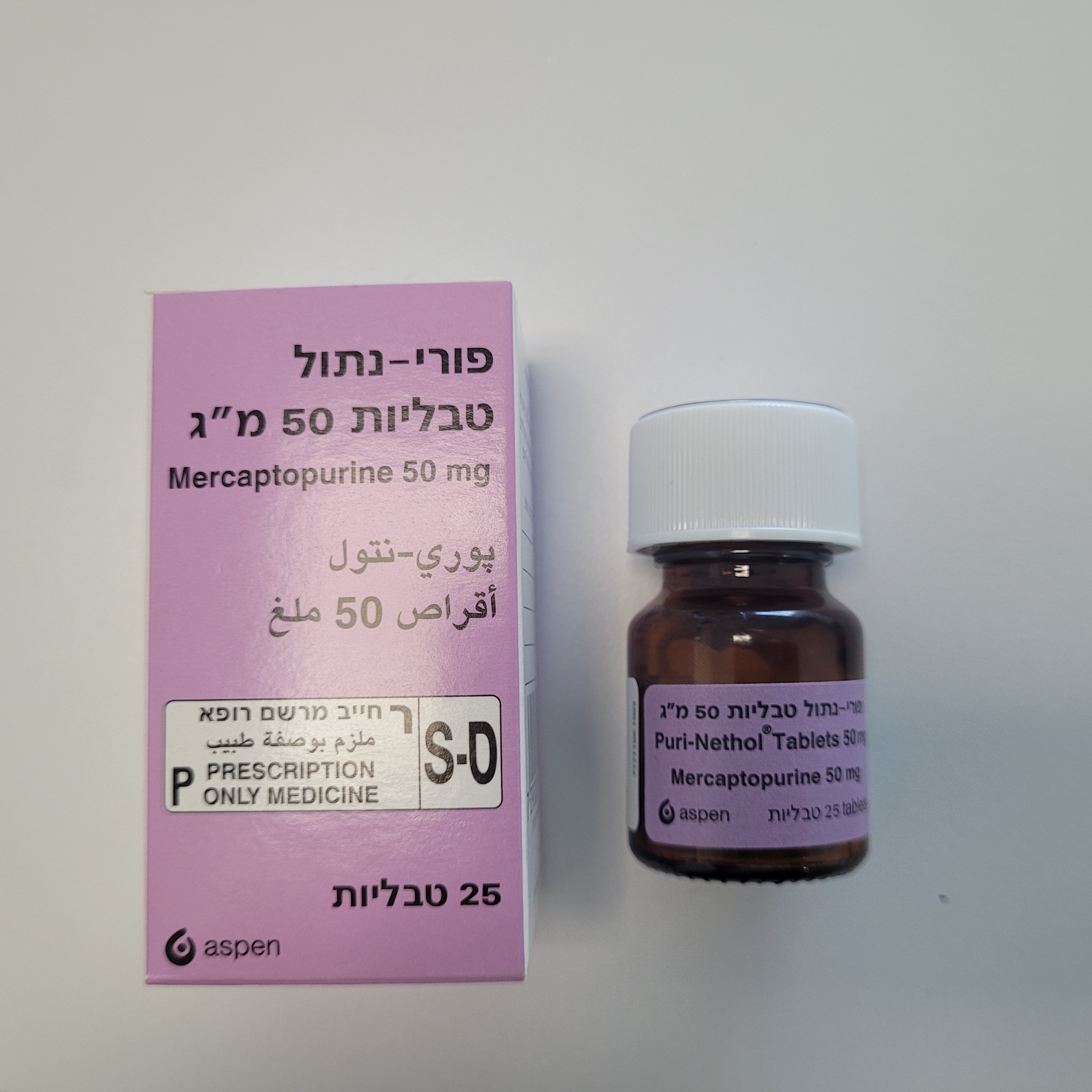Quest for the right Drug

פורי-נתול טבליות 50 מ"ג PURI-NETHOL TABLETS 50 MG (MERCAPTOPURINE)
תרופה במרשם
תרופה בסל
נרקוטיקה
ציטוטוקסיקה
צורת מתן:
פומי : PER OS
צורת מינון:
טבליה : TABLETS
עלון לרופא
מינוניםPosology התוויות
Indications תופעות לוואי
Adverse reactions התוויות נגד
Contraindications אינטראקציות
Interactions מינון יתר
Overdose הריון/הנקה
Pregnancy & Lactation אוכלוסיות מיוחדות
Special populations תכונות פרמקולוגיות
Pharmacological properties מידע רוקחי
Pharmaceutical particulars אזהרת שימוש
Special Warning עלון לרופא
Physicians Leaflet
Adverse reactions : תופעות לוואי
4.8 Undesirable Effects Summary of the safety profile The main side effect of treatment with mercaptopurine is bone marrow suppression leading to leucopenia and thrombocytopenia. For mercaptopurine there is a lack of modern clinical documentation which can serve as support for accurately determining the frequency of undesirable effects. The frequency categories assigned to the adverse drug reactions below are estimates: for most reactions, suitable data for calculating incidence are not available. Undesirable effects may vary in their incidence depending on the dose received and when given in combination with other therapeutic agents. Tabulated list of adverse reactions The following events have been identified as adverse reactions. The adverse reactions are displayed by system organ class and frequency: Very common (≥ 1/10), Common (≥ 1/100 to < 1/10), Uncommon (≥ 1/1000 to < 1/100), Rare (≥ 1/10,000 to < 1/1000) Very rare (< 1/10,000) and Not known (frequency cannot be estimated from the available data) Within each frequency grouping, undesirable effects are presented in order of decreasing seriousness. Body System Side effects Infections and infestations Uncommon Bacterial and viral infections, infections associated with neutropenia Neoplasms Benign, Malignant Rare Neoplasms including lymphoproliferative and Unspecified (including disorders, skin cancers (melanomas and non- cysts and polyps) melanomas), sarcomas (Kaposi's and non- Kaposi's) and uterine cervical cancer in situ (see section 4.4). Very rare Secondary leukaemia and myelodysplasia Hepatosplenic T-cell lymphoma in patients with Not known inflammatory bowel disease (IBD) (an unlicensed indication) when used in combination with anti TNF agents (see section 4.4). Blood and Lymphatic System Very common Bone marrow suppression; leucopenia and Disorders thrombocytopenia Common Anaemia Immune System Disorders Uncommon Hypersensitivity reactions with the following manifestations have been reported: Arthralgia; skin rash; drug fever. Rare Hypersensitivity reactions with the following manifestations have been reported: Facial oedema Metabolism and nutrition Common Anorexia disorders Not known Hypoglycaemia# Pellagra (see section 4.4) Gastrointestinal Disorders Common Nausea; vomiting; pancreatitis in the IBD population (an unlicensed indication), Stomatitis. Rare Oral ulceration; pancreatitis (in the licensed indications) Very rare Intestinal ulceration Hepatobiliary Disorders Common Biliary stasis; hepatotoxicity Uncommon Hepatic necrosis Skin and Subcutaneous Tissue Rare Alopecia Disorders Not known Photosensitivity, erythema nodosum Reproductive system and breast Rare Transient oligospermia disorders # In the paediatric population Description of selected adverse reactions: Hepatobiliary disorders Mercaptopurine is hepatotoxic in animals and man. The histological findings in man have shown hepatic necrosis and biliary stasis. The incidence of hepatotoxicity varies considerably and can occur with any dose but more frequently when the recommended dose of 2.5 mg/kg bodyweight daily or 75 mg/m2 body surface area per day is exceeded. Monitoring of liver function tests may allow early detection of hepatotoxicity. Gamma glutamyl transferase (GGT) levels in plasma may be particularly predictive of withdrawal due to hepatotoxicity. This is usually reversible if mercaptopurine therapy is stopped soon enough but fatal liver damage has occurred. Reporting of suspected adverse reactions Reporting suspected adverse reactions after authorisation of the medicinal product is important. It allows continued monitoring of the benefit/risk balance of the medicinal product. Any suspected adverse events should be reported to the Ministry of Health according to the National Regulation by using an online form: https://sideeffects.health.gov.il In addition, you may also report to: Padagis.co.il

שימוש לפי פנקס קופ''ח כללית 1994
Acute lymphatic leukemia
תאריך הכללה מקורי בסל
01/01/1995
הגבלות
תרופה שאושרה לשימוש כללי בקופ'ח
מידע נוסף
עלון מידע לצרכן
13.06.16 - עלון לצרכן אנגלית 12.04.21 - עלון לצרכן אנגלית 14.08.22 - עלון לצרכן עברית 13.06.16 - עלון לצרכן ערבית 12.04.21 - עלון לצרכן ערבית 19.10.22 - עלון לצרכן אנגלית 19.10.22 - עלון לצרכן עברית 19.10.22 - עלון לצרכן ערבית 06.12.22 - עלון לצרכן 16.03.23 - עלון לצרכן אנגלית 07.06.23 - עלון לצרכן עברית 16.03.23 - עלון לצרכן ערבית 14.08.23 - עלון לצרכן אנגלית 14.08.23 - עלון לצרכן עברית 14.08.23 - עלון לצרכן ערבית 14.09.23 - עלון לצרכן עברית 02.12.23 - עלון לצרכן אנגלית 02.12.23 - עלון לצרכן עברית 02.12.23 - עלון לצרכן ערבית 26.07.15 - החמרה לעלון 02.12.20 - החמרה לעלון 06.12.22 - החמרה לעלון 07.06.23 - החמרה לעלון 14.09.23 - החמרה לעלוןלתרופה במאגר משרד הבריאות
פורי-נתול טבליות 50 מ"ג